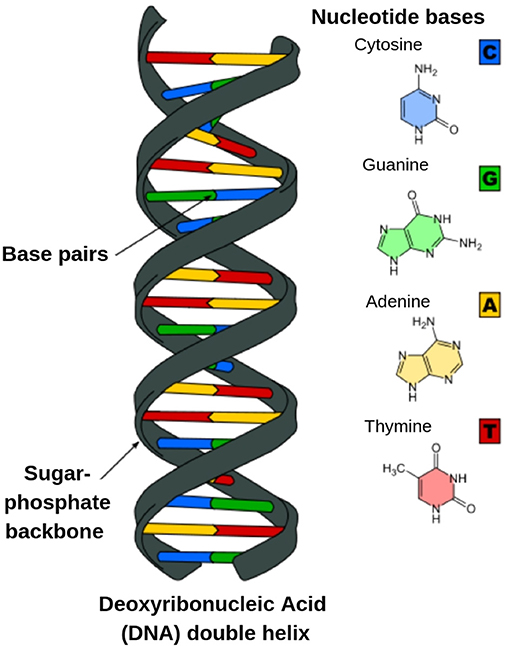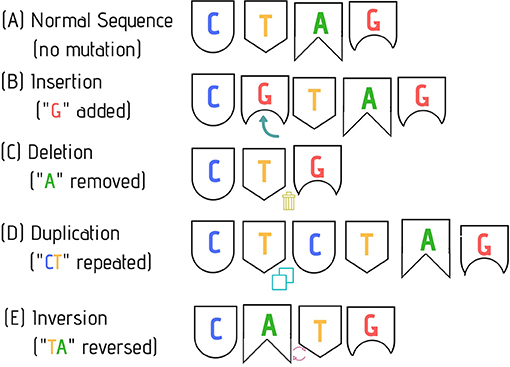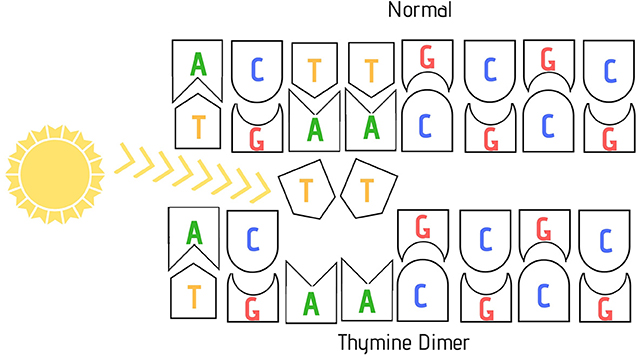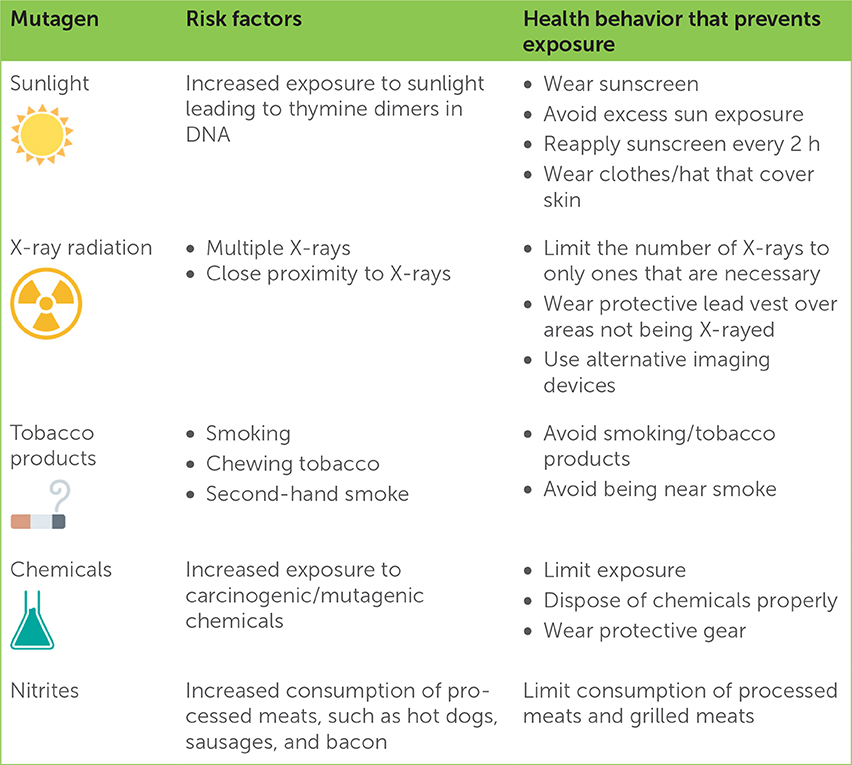What Are Some Diseases That You Know That Come From a Change in an Organisms Dna?
Abstract
Deoxyribonucleic acid is the recipe for all life on Earth, by coding for proteins that the unabridged organism is made of. Our bodies accept complex systems in identify that make sure our Dna is organized properly and that each new cell gets a complete and unchanged re-create. If the complex system involved in copying Dna fails, or if bad things are present in the environment, a fault in the sequence of Deoxyribonucleic acid can occur. These mistakes, called mutations, can happen at whatsoever phase of life, commencement with a growing infant'southward commencement cells all the mode to an adult'due south mature cells. Some mutations cause serious health problems. The purpose of this commodity is to highlight the many harmful villains, chosen mutagens that crusade mutations, and how we can protect our bodies from damage past maintaining a healthy lifestyle and avoiding unnecessary exposure to the types of hazards that can crusade mutations.
What Is DNA?
Without Deoxyribonucleic acid , you would literally not be! Neither would your pet, the copse in your yard, nor the meat, fruits, and vegetables you had for lunch. Anything that is or was live can give thanks Dna! Dna is essentially a recipe that allows an organism to produce the bones materials (proteins) that brand up each cell. Cells piece of work together as tissues, organs, and organ systems to course an entire organism. DNA is fabricated of four different molecules chosen bases: adenine (A), guanine (G), cytosine (C), and thymine (T). These four bases are strung together into a long chain. The backbone linking the bases is referred to as the "sugar-phosphate backbone," because it is made upwards of alternate carbohydrate and phosphate molecules. The order of the bases is referred to as the Dna sequence. Each set of 3 bases in the Deoxyribonucleic acid sequence is referred to as a codon . Nigh codons code for one of the xx amino acids that make up proteins. When the codon does non correspond to an amino acid, it is referred to every bit a cease codon, because it tells the jail cell that the cease of the recipe has been reached and that production of the protein is washed. DNA normally exists as 2 strands that current of air into a shape called a double helix, with the bases on the ii strands paired in a predictable fashion: A always pairs with T, and M with C (see Effigy 1). To farther enhance your understanding of the structure of DNA, we recommend the sweet (pun intended) depiction of the double helix made out of gummy bears and licorice, in the 2018 Frontiers for Immature Minds article about the genetics of heart disease by Clark, Alibhai, and Rutland [ane]!

- Effigy 1 - Drawing of the way 2 strands of DNA pair together to form the double helix structure.
- The chemical structures of the bases are shown on the correct, and they are colour coded so that you lot can come across, in the double helix, that A pairs with T and C pairs with One thousand. The sugar-phosphate backbone is shown as a gray strip holding the bases together. Remixed and Adjusted from Deoxyribonucleic acid RNA by Dr. Osier in Canva. File: Divergence DNA RNA-DE.svg: Sponk/*translation: Sponk [CC BY-SA 3.0 (https://creativecommons.org/licenses/past-sa/3.0), GFDL (http://www.gnu.org/copyleft/fdl.html)], via Wikimedia Eatables.
So, how many of these bases are in that location? Well, homo Dna contains ~three billion bases and virtually 99% of these bases are the aforementioned in all humans [ii]. The 1% divergence contributes to all of the unique traits and characteristics, such as heart color or health status, that vary between you and other people. The ways you are different from your classmates, friends, and siblings is due to your Dna sequences existence different from theirs. About half of your Dna comes from each of your parents. More than 1% departure in Dna means that an organism is a different species than us. Chimpanzee DNA is between 1 and 2% dissimilar from homo Dna (meaning that chimpanzees Dna is 98–99% identical to homo Deoxyribonucleic acid), making them our closest relatives in the animal kingdom [3].
What Is a Mutation?
Now that nosotros understand some basics nigh Dna, we can talk about how the sequence can change. Sometimes our Deoxyribonucleic acid sequence gets contradistinct; this is called a mutation. At that place are unlike types of mutations . For example, a base can exist changed from what it was originally supposed to be to a different base (exchange), a base or bases tin exist deleted from the Deoxyribonucleic acid (deletion), a base or bases can exist added to the DNA (insertion), or a piece of Deoxyribonucleic acid can be flipped (inversion) or repeated (duplication) (see Figure 2).

- Effigy ii - Examples of common types of mutations.
- (A) The "normal" Dna sequence without a mutation, (B) an insertion, where a base is added, (C) a deletion, where a base is removed, (D) a duplication, where some bases are repeated, and (Eastward) an inversion, where the order of bases is reversed.
While mutations always alter the Deoxyribonucleic acid sequence, they exercise not always cause a modify in the resulting protein or an obvious outcome on the organism. This can occur because almost amino acids can be coded by two or more different codons. For instance, the DNA sequence CAA codes for the amino acrid valine, but so does the sequence CAG. So, if a substitution mutation changes the Deoxyribonucleic acid sequence from CAA to CAG, a valine would still be added to the protein. Mutations that do not touch the protein are called silent mutations, because the DNA still makes the same protein that would be expected, and a person with a silent mutation would non even realize it. Other times, the modify in the Dna sequence does affect the protein. This tin happen, for example, if the DNA sequence CTC is inverse to CAC. In this example, the amino acrid glutamic acid would exist replaced with valine. This specific sequence change is the mutation found in almost people with sickle jail cell anemia, which is a very painful condition. Other times, a base of operations is inserted into or deleted in the Dna sequence, which alters the way codons are read. This results in a large number of amino acids being contradistinct, which is called a frameshift mutation. For case, if the original sequence AAA-CCC-GGG has a T added afterward the starting time A, it would now be read as ATA-ACC-CGG-Thousand…; this would alter the amino acid sequence from phenylalanine-glycine-proline to tyrosine-tryptophan-alanine. Notice how none of the amino acids in the protein made from the mutated DNA are the same every bit the original sequence. This would probable take a big impact on the protein's function! A third possibility is that the mutated DNA sequence causes the poly peptide product to stop early, so that the poly peptide is shorter than normal. This is referred to as a nonsense mutation. If the Deoxyribonucleic acid sequence AAA-ACC-AAA-AAA were changed to AAA-Deed-AAA-AAA, the protein sequence would change from phenylalanine-tryptophan-phenylalanine-phenylalanine to a single phenylalanine only, because the sequence Human action would human activity equally a stop codon. So, the resulting protein would be shorter than normal and would not function properly.
Mutations tin be passed down from the mother or begetter to the developing baby, and these are chosen inherited mutations . For example, if your mother had a mutation that acquired her to be a lot shorter than average, you lot could inherit her mutation and exist shorter than average yourself. You might tell your friends that y'all got your brusque stature from your mom, or that being short runs on your mom'due south side of the family. If a person with an inherited mutation has a baby one day, that person would pass the mutation on to the adjacent generation. With the example above, if yous gave your son or daughter the curt stature mutation your mom gave you, your child could say he is short considering of both you lot and his grandmother (your mother).
Other mutations happen after birth, and these are chosen acquired mutations . Acquired mutations are normally due to something in the environment and their effects are ordinarily just present in the cells that were exposed to that environmental trigger. So, some cells will have the mutation and other cells will have the normal sequence. For example, if you lot somehow got a mutation in the skin cells on your knee and then scraped your human knee and had to make new cells to supervene upon the ones that got injure, those new cells would contain the mutation. However, the mutation would non be passed on to your future offspring, if you had a baby later.
What Are Sources of Mutations and How Tin I Prevent Them?
Sunlight
Sunlight is one matter that can cause mutations. How does sunlight affect our Dna? Sunlight creates structures chosen thymine dimers , which means that two thymine (T) bases (T) on the same DNA strand become connected in an aberrant style, instead of correctly attaching to the complementary base adenine (A) on the opposite strand. Thymine dimers create kinks in the Dna shape (meet Figure iii) [2]. These kinks make Dna difficult to copy, which can crusade a mutation. In order to avoid thymine dimers from developing in our cells, it is very important to use sunscreen to assist block ultraviolet A and B (UVA and UVB) rays. The United States Nutrient and Drug Agency (FDA) recommends a sun protection cistron (SPF) of at to the lowest degree fifteen, to protect against pare cancer and early peel aging (see Table 1). Sunscreen should be reapplied every 2 h or after swimming, sweating, bathing, or using a towel [4]. Some individuals who have especially sensitive or calorie-free peel should consider higher levels of UV protection and are encouraged to consult a medico called a dermatologist, who is an expert on keeping skin good for you.

- Figure 3 - The ultraviolet (UV) rays in sunlight cause the germination of thymine dimer mutations, which is when two thymines on the same strand of DNA bond together instead of correctly bonding with adenines on the opposite strand.
- This can crusade mutations when making a copy of Dna for the next generation of cells.

- Table 1 - Environmental factors that tin can cause mutations.
X-ray Radiation
X-ray radiation is the kind used in X-rays (medical images) taken of teeth, bones, and other hard torso parts. Ten-ray radiations has a very high energy level that can create molecules called gratis radicals. Free radicals are very unstable, and to become more than stable, they can steal electrons from DNA, which tin can lead to mutations [5]. Nosotros tin reduce exposure to X-ray radiation by using other forms of medical images when possible and wearing protective equipment to protect the trunk when x-rays are taken. If you lot have ever gone to the dentist and had an X-ray of your teeth, you probably remember having a heavy lead frock draped over your body. The lead apron protects the parts of the torso that the dentist is non taking pictures of. Getting X-rays only when necessary is a skilful exercise to foreclose any excessive negative furnishings on your Dna (run into Table ane) [5]. This is why 10-rays are not taken if a doctor is fairly certain a patient has sprained, not broken, an talocrural joint.
Cigarettes and Other Tobacco Products
How does smoking lead to cancer? Cigarettes and tobacco products incorporate chemicals referred to every bit carcinogens , which are mutagens that are as well known to cause cancer. All cancer cells have DNA mutations, and it is the carcinogens that cause the mutations. Carcinogens cause mutations past damaging the way the cell repairs Dna or makes proteins. If the cancer cell is not able to repair this DNA damage, then it will keep dividing to make new cells and will pass the mutation on to all the new cells that are made. Because cancer cells grow and dissever faster than normal cells, masses of these abnormal cells, called tumors, tin course. The best way to avert these carcinogens is not to smoke or utilise tobacco products (see Table 1). Information technology is likewise important to try to limit second-mitt smoke exposure, which means avoiding other people who are smoking cigarettes [six].
Chemicals
Chemical mutagens are chemicals that have been shown to cause mutations. Some chemicals are as well carcinogens and tin can crusade cancer in humans, like the ones in cigarette smoke discussed higher up [2]. Another examples of chemical mutagens include benzene (a major component of gasoline), vinyl chloride (common in pipes), and arsenic (used in some insecticides and rat poison). Some chemical mutagens have not been linked to cancer. If they are not 100% known to cause cancer, these chemicals are simply referred to as mutagens, non carcinogens. To avoid mutations, we need to limit exposure to these chemicals by using protective equipment, similar masks and gloves, when working with them. Once these chemicals are no longer beingness used, they should be properly disposed of (see Tabular array ane).
Nitrites
Substances chosen nitrites are present in many processed meats, such as bacon, pastrami, salami, hot dogs, and sausages. Nitrites combine with the proteins in the meat to form other compounds, which are known to be carcinogens [vii]. Now I know what y'all are thinking: do I have to give up my favorite foods altogether? Fortunately, the answer is no. You tin can still eat candy meats simply eating them every twenty-four hours is probably not the best idea. To protect yourself from nitrites, yous should limit your consumption of processed meats and as well attempt to include healthy choices in your nutrition, similar fruits, vegetables, and whole grains (see Table i).
Conclusion
Now that yous know what mutations are and how acquired mutations happen, you can take the necessary steps to help preclude yourself from getting mutations, and you lot can teach your friends and family about the steps they can take in their daily lives to avoid mutagens. There are more causes of mutations than we take described here, and many of them are beyond our control. That is why it is really important to forbid equally many mutations as we tin can, so that nosotros limit the negative effects of mutations on our health. Your Dna is such a critical molecule, it is worth protecting it however you can!
Glossary
Deoxyribonucleic Acid (Dna): ↑ The molecular "recipe" that contains the instructions for an organism. Dna is fabricated of iv bases held together by a sugar-phosphate background. Deoxyribonucleic acid is present in all living organisms and is responsible for helping pass on genes when cells divide.
Codon: ↑ A set of three bases in Deoxyribonucleic acid that codes for one amino acid.
Mutations: ↑ Changes in an organism'due south Dna sequence that may or may non alter proteins.
Inherited Mutations: ↑ A mutation that is passed down from the mother or the begetter.
Acquired Mutations: ↑ A mutation that is caused by ecology factors and does not bear on cells passed down to futurity offspring.
Thymine Dimers: ↑ A mutation that occurs on a unmarried strand of DNA, when ii thymines get connected to 1 another, instead of to adenines on the second strand of DNA.
Carcinogens: ↑ Substances/chemicals that tin can cause mutations that tin result in cancer.
Mutagens: ↑ Substances/chemicals that cause changes in an organism'due south Deoxyribonucleic acid sequence.
Disharmonize of Interest Statement
The authors declare that the research was conducted in the absence of whatsoever commercial or financial relationships that could be construed as a potential disharmonize of interest.
References
[1] ↑ Clark, N., Alibhai, A., and Rutland, C. S. 2018. Mending a broken center–the genetics of center disease. Front. Young Minds half-dozen:19. doi: 10.3389/frym.2018.00019
[two] ↑ Ackerman, South., and Horton, W. 2018. Chapter 2.4–effects of ecology factors on Deoxyribonucleic acid: damage and mutations. Dark-green Chem. one:109–28. doi: 10.1016/B978-0-12-809270-5.00005-4
[3] ↑ Ebersberger, I., Metzler, D., Schwarz, C., and Pääbo, S. 2002. Genomewide comparison of Deoxyribonucleic acid sequences between humans and chimpanzees. Am. J. Hum. Genet. 70:1490–7. doi: x.1086/340787
[iv] ↑ Latha, M. South., Martis, J., Shobha, V., Shinde, R. S., Bangera, S., Krishnankutty, B., et al. 2013. Sunscreening agents. J. Clin. Aesthet. Dermatol. 6:16–26.
[5] ↑ ACHRE. 1994. Advisory Commission on Human Radiation Experiments Study. Retrieved from: https://bioethicsarchive.georgetown.edu/achre/final/summary.html#publication
[six] ↑ Centers for Disease Control and Prevention (United states), National Center for Chronic Disease Prevention and Health Promotion (U.s.a.), and Office on Smoking and Health (The states). 2010. How Tobacco Fume Causes Illness: The Biology and Behavioral Basis for Smoking-Attributable Affliction: A Written report of the Surgeon General. Atlanta, GA: Centers for Disease Control and Prevention (U.s.a.). Retrieved from: https://www.ncbi.nlm.nih.gov/books/NBK53010/
[vii] ↑ Baena Ruiz, R., and Salinas Hernández, P. 2014. Diet and cancer: risk factors and epidemiological evidence. Maturitas 77:202–viii. doi: ten.1016/j.maturitas.2013.11.010
Source: https://www.frontiersin.org/articles/420965
0 Response to "What Are Some Diseases That You Know That Come From a Change in an Organisms Dna?"
Post a Comment